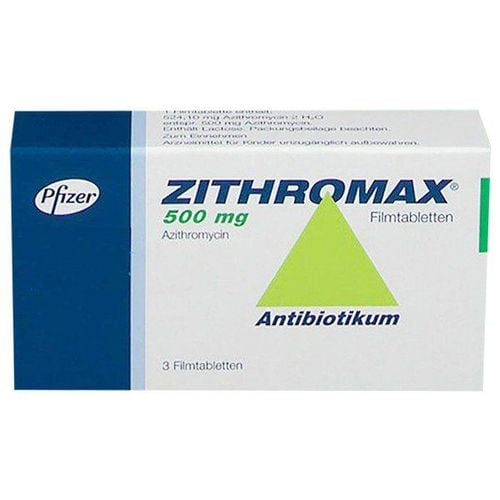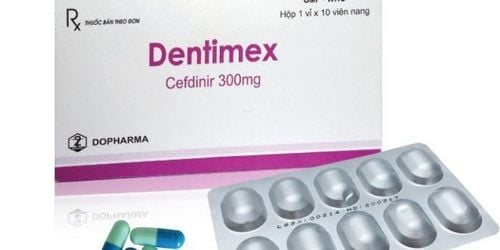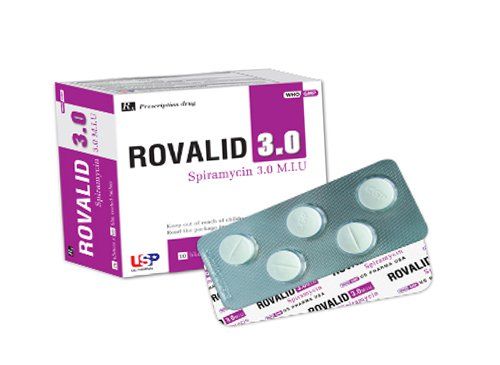This is an automatically translated article.
Tinforova belongs to the group of drugs against infections, parasites, viruses and fungi. The drug has the main ingredient is Spiramycin 3,000,000 IU, which helps to treat and prevent infectious diseases such as bronchial pneumonia, otitis media, skin infections...
1. What is Tinforova?
Tinforova medicine with ingredients Spiramycin 3,000,000 IU, prepared in film-coated tablet form, box of 1 blister x 10 tablets, manufactured by Gia Nguyen CPDP Company, registration number in Vietnam market is VD- 30371-18.
Spiramycin is a macrolide antibiotic, with a broad antibacterial spectrum and stronger potency than the antibiotic Erythromycin. Tinforova has a bacteriostatic effect on bacteria that are dividing cells, the mechanism of action of the drug is to prevent bacteria from synthesizing proteins. In serum, the drug Tinforova has a mainly bacteriostatic effect, but when high concentrations are reached, the drug can be slow bactericidal against susceptible bacteria, including:
Tinforova has more than 90% of susceptible strains of bacteria. (MIC ≤ 1mcg/ml) typically: Gram-positive aerobic bacteria: Baccilus cereus, Staphylococcus meti - R*, Streptococcus pneumoniae, Enterococci, Staphylococcus meti-S, Streptococcus B, Streptococcus pyogenes. Gram-negative aerobic bacteria: Bordetella pertussis, Branhamella catarrhalis, Moraxella. Anaerobic bacteria: Actinomyces, Bacteroldes, Enbacterium. (4) Other bacteria: Mycoplasma pneumoniae, Chlamydia , Coxiella, Leptospires, Borrelia burgdorferi. Infrequently susceptible bacteria: Streptococcus pneumoniae, Enterococcus, Clostridium perfringens. Resistant bacteria (MIC > 4mcg/ml): More than 50% of typical resistant strains are Meticillin-resistant Staphylococcus, Enterobacteriaceae, Pseudomonas, Acinetobacter, Haemophilus influenzae. Tinforova is rapidly absorbed in only 20 minutes but not completely. After oral administration of Tinforova 6 million UI, peak serum concentration reached 3.3mcg/ml, half-life of 8 hours. Extremely well diffused into saliva and tissues, after 10 days of discontinuation of treatment, the drug still has 5-7 mcg/g of active substance in spleen, liver, and kidney. Tinforova does not cross the cerebrospinal fluid, crosses breast milk, binds only 10% of plasma proteins, and is slowly metabolized in the liver.
Tinforova drug is greatly eliminated via bile, the concentration in bile is 15-40 times higher than the serum concentration, so a large amount is found in the faeces, 10% of the oral dose is excreted in the urine.
2. What are the effects of Tinforova?
Tinforova medicine is used in the treatment and prevention of the following infections:
Treatment of infections caused by susceptible bacteria such as: pharyngitis, acute sinusitis, acute bronchitis superinfection, exacerbation of inflammation Chronic bronchitis, community-acquired pneumonia, atypical pneumonia. Tinforova is the drug of second choice in case the patient cannot take beta-lactam antibiotics. Treatment of benign skin infections: Impetigo, skin and subcutaneous infections, oral infections, non-gonococcal genital tract infections. Prevention of meningococcal meningitis in patients contraindicated or resistant to rifampicin. Prevention of recurrence of acute rheumatic fever in patients already allergic to penicillin. Treatment of Toxoplasma infection in pregnant women.
3. Contraindications of Tinforova
Patients who are sensitive or allergic to Spiramycine or any of the ingredients of Tinforova.
4. Dosage, how to use Tinforova
Dosage: The dose of Tinforova should be according to the doctor's instructions, the reference dose is as follows:
Adults: Tinforova 6.0 - 9.0 million IU/day, divided 2-3 times. In case of severe infection, the maximum dose is 15.0 million IU/day, divided into 4-6 times/day. Infants and children: Tinforova dose 150,000-300,000 IU/kg/day, divided into 2-3 times. Prevention of meningococcal meningitis:
Adults: 3 million UI/12 hours of treatment for 5 days. Children: 75,000 UI/kg/12 hours of treatment for 5 days. How to use:
Tinforova is used orally, should not chew the tablet, must take the whole tablet with filtered water. Time to take Tinforova 3 hours before or after a meal so that the drug is not affected by food. Once you have used Tinforova, you must follow the full course of treatment, do not arbitrarily stop the drug when the symptoms of the disease are relieved. If you miss a dose you need to skip, do not overlap with the next dose. Do not skip doses more than 2 times in a row during treatment.
5. Undesirable effects of the drug Tinforova
Common:
Digestive disorders: Nausea, vomiting, bloating, indigestion, diarrhea. Dizziness, headache. Uncommon:
Fatigue, sweating, nosebleeds, feeling of heaviness in the chest. M Urticaria, rash, (red and itchy skin rash), angioedema (swelling of the face/neck/lips/tongue due to allergies). Rare:
Anaphylactic reactions, superinfection due to long-term oral administration of Tinforova. Electrocardiogram showed prolonged QT interval. Changes in blood cell counts: Anemia can be caused by hemolysis. Overdose: To date, there have been no studies to determine the toxic dose of Tinforova. Symptoms may appear on the gastrointestinal tract such as: Nausea, vomiting, diarrhea, electrocardiogram with prolonged QT interval.
How to handle: If you accidentally overdose and have serious side effects, you should immediately go to the medical center for timely treatment, currently there is no specific drug to treat Tinforova poisoning but mainly treatment. symptom.
Note: The above is not a complete list of all the side effects of Tinforova, so if you have any symptoms, please notify your doctor immediately for timely treatment and monitoring.
6. Notes when using Tinforova
It is necessary to inform your doctor about your medical history, drug allergies, drugs or supplements being used at the present time to have appropriate instructions for use, to avoid drug interactions that cause decreased undesirable effects or complications. Using Tinforova simultaneously with oral contraceptives will lose the effectiveness of contraception, so do not use birth control pills during Tinforova treatment. The drug Tinforova inhibits the absorption of carbidopa, reducing Levodopa plasma concentrations, so clinical monitoring and Levodopa dose adjustment are necessary. Tinforova can be toxic to the liver, so it is necessary to be careful and adjust the dose according to the advice of the doctor when using the drug for people with liver dysfunction. Although there is no need to adjust the dose of Tinforova for patients with renal impairment, you should not self-administer Tinforova without consulting your doctor. Use caution when using for people with a history of heart disease, arrhythmia, prolonged QT interval because of some undesirable effects of the drug, including cardiovascular symptoms. Therefore, to ensure safety for your health, you should inform your doctor about your current condition so that he can make the right choice for you. Tinforova can be used in pregnant women without any adverse reactions. The drug can pass into breast milk, so it is best not to or limit its use during breast-feeding. Occasionally, dizziness and headache may be experienced when using Tinforova, so caution should be exercised when using the drug for drivers and operators. During the use of Tinforova antibiotics, patients need to follow the instructions on the dose of the treating doctor, avoid arbitrarily increasing or decreasing the dose. Patients should consult their treating physician before stopping using the drug, not arbitrarily stopping the drug or taking a prolonged dose. Store the medicine in a dry place, the temperature is below 30 degrees Celsius, avoid direct sunlight and out of reach of children to prevent children from taking the medicine without knowing it. Above is information about uses, dosage and precautions when using Tinforova. To ensure safety and maximize the effectiveness of treatment, you need to consult your doctor, do not arbitrarily use drugs without a prescription.













